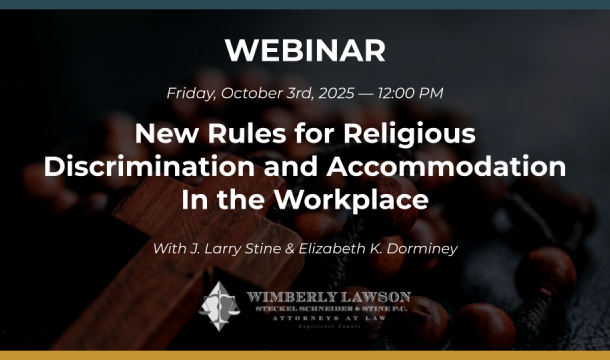Proposed Enforcement Guidance on Harassment Expands Trump Administration's Guidance Significantly
On September 29, 2023, the Equal Employment Opportunity Commission (EEOC) proposed new enforcement guidance on harassment, subject to public input for a period of 30 days after its publication (November 1). A similar guidance that was issued during the Trump Administration never was finalized, allegedly due to LGBTQ-related issues. The Trump Administration proposed a guidance closely tracking the case law, but the new guidance seems to extend the case law. This article will first address some of the ways the new proposed guidance seems to expand the existing harassment case law. Such EEOC interpretations are followed by the courts only to the extent they are found to be persuasive.
Addressing a situation where an employee did not complain until four months later, and after accepting a position with another employer, the EEOC says the employer is liable for the initial incident because the employee could not have avoided this harm by complaining earlier.
The EEOC states that there may be reasonable delays in complaining or in failing to use the employer's complaint procedure. One is where an employee had a reasonable belief that the complaint process was ineffective, such as where persons designated to receive complaints were close friends of the harasser. Another is where the employee reasonably feared retaliation as a result of complaining about harassment, such as where the employee or another employee had previously been subjected to retaliation for complaining about harassment. Other circumstances are where the employee took other reasonable steps rather than using the employer's complaint process, such as filing a union grievance, or reporting the harassment to another entity and reasonably expecting that entity to correct the problem.
The employer's duty to take corrective action may be triggered by notice of harassing conduct that has not yet risen to the level of a hostile work environment, but may reasonably be expected to lead to a hostile work environment if appropriate corrective action is not taken.
Notice of harassing conduct directed at one employee might serve as notice not only of the harasser's potential of further harassment of the same employee, but also of the harasser's potential to harass others.
The guidelines address systemic harassment, harassment affecting multiple complainants. It states that evidence of widespread harassment could be used to establish that each employee working on a shift was individually subjected to an objectively hostile work environment.
To address liability in a pattern-or-practice case, the employer must adopt a systemic remedy, rather than only address harassment of particular individuals. If there have been frequent individual incidents of harassment, then the employer must take steps to determine whether that conduct reflects the existence of a wider problem requiring a systemic response, such as developing comprehensive company-wide procedures.
The above items seem to be somewhat of an expansion of the current case law. In addition to these aggressive interpretations, the guidelines summarize various aspects of the harassment issue.
This article is part of our November 2023 Newsletter.
View newsletter online
Download the newsletter as a PDF
Related Content
Get Email Updates

Trump Nominates Appointments to NLRB and EEOC but Policy Changes Likely to Be Delayed

DOL Launches Self-Audit Programs Designed to Help Employers Improve Compliance

DOL Must Release EEO-1 Reports to the Public under Open Records Laws

Current Advice on Active-Shooter Situations

New Policy for Federal Workers and Religious Expressions
